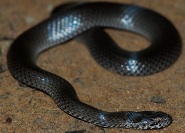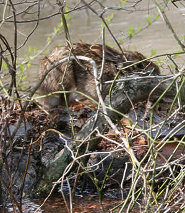Friday 29 January 2010 Ornamental snake
 The ornamental snake is an Australian snake. Poisonous, the snake belongs to the cobra family. These snakes have short tangs with paralyzing venom. With a stout body, wide flat head distinct from the neck, and a stout body, Ornamental snakes have their own presence. The scales on the body are of lighter shade with dark streaks, giving the snake an amazing appearance. As the belly is creamish or on the whiter tone, it reflects a stark contrast with the upper and lower abdominal part thus giving the snake a unique identity.
The ornamental snake is an Australian snake. Poisonous, the snake belongs to the cobra family. These snakes have short tangs with paralyzing venom. With a stout body, wide flat head distinct from the neck, and a stout body, Ornamental snakes have their own presence. The scales on the body are of lighter shade with dark streaks, giving the snake an amazing appearance. As the belly is creamish or on the whiter tone, it reflects a stark contrast with the upper and lower abdominal part thus giving the snake a unique identity. The snake is found in the Brigalow woodland belt. It is usually found inhabiting on clay and sandy soils. It also grows on natural leaves found near the rivers, forests and marshy areas. Sites which are rich in ground cover with fallen dead leaves, timber, twigs, loose bark are also inhabited by Ornamental Snakes. The site with abundance of frog dwelling in marsh or a pool of accumulated water, become very attractive to this species of snakes as frogs seem to be their staple diet and offer a good meal to them. To elaborate, the diet of Ornamental snakes consists exclusively of frogs. The very reason clarifies the abundance of Ornamental snakes at a site near Nebo, which is considered to be the hub of young frogs.
A thorough research indicates that these snakes make a repeated attempt to attack these frogs and do not consume them immediately. This was evident from the snakebites signs found on the toads and frogs, around the trap site. But as the frogs are very attractive to these snakes, even some large toads and frogs were found dead or killed every morning. One distinctive feature is that Denisonia maculate species is very aggressive and stoic. It never kills it prey instantly. The dead bodies of frogs found near the dwelling sites of these snakes reveal, extensive injuries with skull raptures and cell breakdown.
The Ornamental snake is similar in size in both its genders. Be it male or female both are of similar size and texture and possess huge fangs in front of their mouth. These snakes are found only around a small area of Queensland in Australia. Even in Queensland the snake is found mainly in the Brigalow region, along the basin of Fitzroy and Dawson Rivers.
Throughout an extensive research done on this species, its population reflected a steady uniformity without any significant changes. Yet as the development in the surrounding areas is taking pace the habitat of Denisonia Maculata is considered to be under a threat. Grazing, deforestation, crop production is leading to the clearing of marsh and under cover regions, which were the dwelling sites of the Ornamental snakes. Moreover a deliberate attempt to introduce foxes and cats can also pose a threat to these snakes as they become a natural prey to the cat family. One other looming threat is the indigestion of poisonous cane toad, which is abundant near the inhabited area, by the ornamental snakes leading to immediate death. Though the snake species is not yet decreasing in its population yet if it is not conserved sooner then it may lead to a sharp decline in its population.
Considering the gravity of the situation the Australian Reptiles Association has briefed various objectives and strategies to conserve the species. A deliberate attempt is being made to educate about the biology and ecology of the ornamental snake, their distribution, population status, possible dangers and developing awareness of the snake’s contribution in preserving environment and maintaining an eco balance. Special reserves have been developed to reduce the threats to the species still dwelling outside the reserves.
Picture of the ornamental snake by Stewart Macdonald (Smacdonald), licensed under the Creative Commons Attribution 2.5 Generic license You can help spreading the word about this animal by liking it on facebook

 The
The